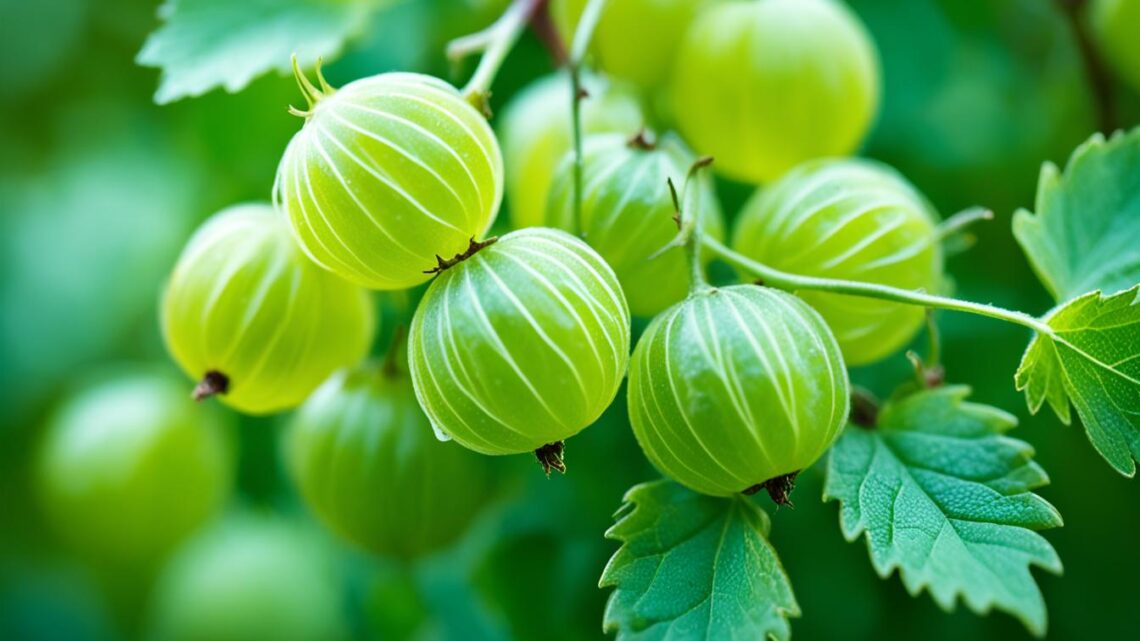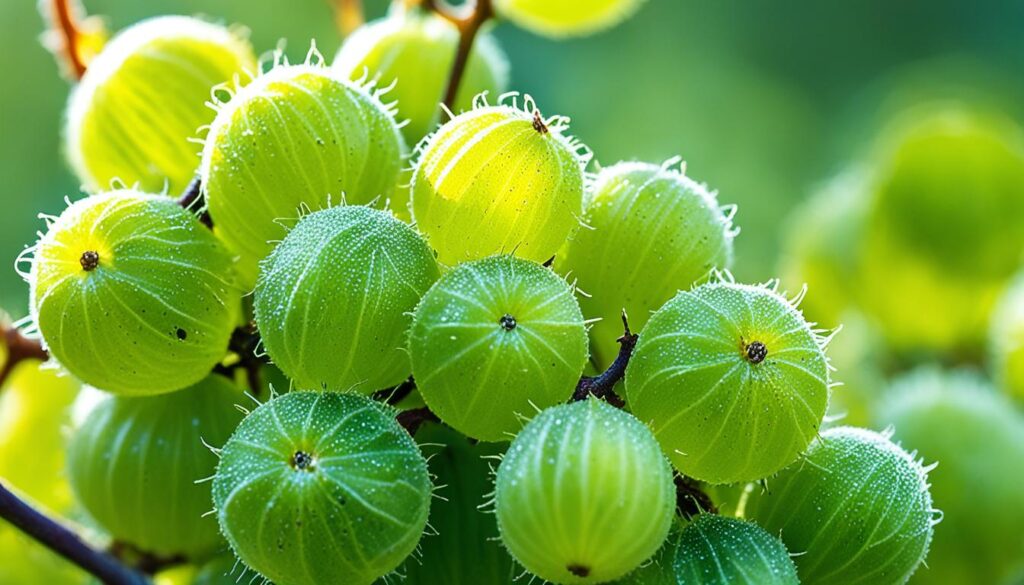
Have you ever tried gooseberries? These small, round berries mix sweet and tart flavors perfectly. They’re great in many dishes, from jams and pies to sorbets and sauces. But why do people love them so much?
Let’s dive into the world of gooseberries. We’ll look at their history, kitchen uses, and health benefits. Whether you garden or cook at home, gooseberries are worth exploring. Come see the joy they bring to food.
Embracing the Tangy Gooseberry Sensation
Gooseberries have a unique taste that makes them stand out. They are tangy but also sweet, offering a refreshing experience. Enjoy them fresh, in pies, or as jams and sauces, and see how versatile they are.
Relish the Unique Flavor Profile
Gooseberries are famous for their gooseberry flavor. This flavor is a mix of tart and sweet. They can taste from slightly sour to tangy, with a sweet undertone that adds depth.
Unleashing Gooseberry’s Versatility in Recipes
Gooseberries are great for more than just eating fresh. They can be used in many dishes, sweet and savory. Try them in pies, jams, sauces, chutneys, or even savory dishes for new tastes.
Gooseberries are a key ingredient in the kitchen. They let you explore gooseberry baking and create new dishes.

Gooseberry Cultivation: A Rewarding Journey
Cultivating gooseberries is a rewarding journey for gardeners. These hardy plants grow well in many climates and soils. They are great for both experts and beginners. When picking the right gooseberry variety, think about size, color, and taste for a great harvest.
Selecting the Perfect Gooseberry Variety
With the right care, gooseberry bushes give a lot of this special fruit. Some top gooseberry varieties are:
- American Smoothstem: A medium-sized variety with a sweet and tangy flavor profile.
- Captivator: A large, deep-red gooseberry with a rich, complex taste.
- Invicta: A vigorous, productive plant that produces large, greenish-yellow gooseberries.
- Hinnonmäki Red: A compact, high-yielding plant with deep-red, tart gooseberries.
When growing gooseberries, think about your climate, soil, and space. This helps pick the best variety for your garden. With the right gooseberry plants, you’ll enjoy a big and tasty harvest every year.
The «From Seed to Spoon» app has info on growing over 80 foods, including gooseberries. Co-founder Carrie Spoonemore helps people grow their own food. She gives tips on fighting pests and drawing in good insects in the garden.
Savoring Gooseberry’s Culinary Delights
Gooseberries are a treat in the kitchen, perfect for many dishes. Whether making gooseberry jam or a gooseberry pie, these berries add a special touch to your cooking and baking.
Gooseberry Jam: A Classic Spread
Gooseberry jam is a favorite, with its mix of tart and sweet. Enjoy it on toast, scones, or in pastries. Making gooseberry preserves is easy, letting you enjoy the fruit’s unique taste. Pair it with warm baked goods for a special treat.
Gooseberry Pie: A Tart and Tantalizing Treat
The gooseberry pie highlights the fruit’s tangy flavor. It’s a tart delight that’s great on its own or with vanilla ice cream. Choose a classic double-crust or a crumble topping to make it even better.
Gooseberries are great for both sweet and savory dishes. They add a special touch to your gooseberry baking and cooking. Try these berries and see how they can make your dishes stand out.
The Enchanting Gooseberry Season
The gooseberry season is a magical time, filled with the tart taste of these berries. They reach their best in summer, offering a short time to enjoy them. Gardeners and food lovers look forward to this season for its unique flavors and uses.
Gooseberries belong to the Ribes grossularia species and come from Europe, northwestern Africa, and parts of Asia. Dorothy Wordsworth wrote about enjoying gooseberries in her journal in the early 1800s. She loved them with sugar or at friends’ places, showing their timeless charm.
| Date | Gooseberry Mentions |
|---|---|
| 6 August 1800 | Gooseberry entry |
| 7 August 1800 | Gooseberry entry |
| 8 August 1800 | Enjoyed gooseberries at Mr. Simpson’s place |
| 15 August 1800 | Feasted on gooseberries at Silver Hill |
| 29 May 1800 | Miss Simpson brought gooseberries and cream |
Gooseberries are not just tasty; they’re also good for you. They’re full of antioxidants and pectin, making them great for jams, pies, ice creams, and syrups. Their unique flavor is a treat for food lovers.
As the gooseberry season comes, people can’t wait to enjoy these berries. Whether you grow them, cook at home, or love trying new foods, this season is a chance to enjoy summer’s best. It’s a time to savor the taste of these special berries.
Uncovering Gooseberry’s Nutritional Treasures
Gooseberries are more than just a treat for your taste buds. They are full of important vitamins, minerals, and antioxidants. These nutrients are key for your health and well-being. By learning about gooseberries’ nutritional benefits, you can add them to your diet and enjoy their health perks.
Gooseberry’s Health Benefits Unveiled
Gooseberries are packed with vitamin C, which is great for your immune system and skin. They also have a lot of vitamin A, which helps with your vision and immune health. Plus, they’re a good source of iron, which is important for making blood, and minerals like phosphorus and calcium for strong bones.
These berries are also full of B vitamins like niacin, riboflavin, and thiamin. These vitamins help with metabolism, skin, nerve function, and keeping you energized. They also have some vitamin K, which is good for blood clotting and bone health.
Gooseberries have a mix of carbohydrates, protein, and fiber. Carbs give you energy, protein helps with repairing tissues, and fiber is good for your digestive system.
| Nutrient | Benefit |
|---|---|
| Vitamin C | Immune function, skin health |
| Vitamin A | Vision, immune support |
| Iron | Blood production |
| Phosphorus | Bone health |
| Calcium | Bone structure and health |
| B Vitamins | Metabolism, skin, nerve function, energy production |
| Vitamin K | Blood clotting, bone metabolism |
| Protein | Tissue repair |
| Fiber | Digestive health |
Gooseberries are also loaded with antioxidants and polyphenols. These substances help fight inflammation and may help with weight management and reduce the risk of chronic diseases.
Elevate Your Classroom with Inspiring Gooseberry Posters
Make your teaching space more exciting and capture your students’ attention with our beautiful gooseberry posters. These posters are designed to spark curiosity and make learning fun. They can change how your classroom decor looks and help students connect with the material better.
Looking for a standout piece or a set of posters? Our collection has many themes and designs for your teaching resources. Each poster is printed on 11×17 paper. You can laminate them to make them last longer in your busy classroom.
Our gooseberry posters feature vibrant illustrations and useful info. They mix beauty with learning, showing students the interesting world of this fruit. This can start discussions, help students understand better, and make them love learning more.
Upgrade your teaching and make your classroom special with our gooseberry posters. Find the right posters for your classroom and improve learning today.
From Bushes to Baskets: Harvesting Gooseberries
Embracing Sustainable Gooseberry Farming
Turning gooseberry bushes into baskets is a fulfilling task for gardeners and farmers. Gooseberry harvesting needs a gentle touch and an eye for when they’re ripe. It’s key to use sustainable gooseberry farming methods to keep this fruit around for the future. These methods help the environment and make sure we can enjoy this tasty fruit for years to come.
It takes about three years for gooseberry plants to give a big harvest. In the first year, you might not get any fruit to focus on root growth. But, you’ll get a small harvest in the second and third years. Gooseberries start growing in late spring or early summer and can keep going until September starts.
Knowing when to pick gooseberries is important. Look for size, color, and texture to tell if they’re ripe. Tasting berries from different spots on the plant helps you find the perfect ones. Picking them a bit early is best for making jam because it keeps the pectin levels high.
Using drip irrigation and proper pruning helps make gooseberries better and more abundant. Bird netting and the «shake» method can also protect your fruit from birds. These methods help growers keep this fruit around for everyone to enjoy.
There’s usually only room for about 12 to 15 quarts of gooseberries at farmers markets each week. The picking season lasts around six weeks, from late May to early July. With the right care and sustainable farming, growers can have a great gooseberry harvest every year. This brings joy to cooks at home and in restaurants alike.
Unleash Your Creativity with Gooseberry Recipes
Gooseberries are a blank canvas for cooks at home and chefs. They can be used in many ways, from savory sauces to sweet pies. Use gooseberries in different dishes to surprise your guests and family.
Gooseberries can make your meals special. Try them in savory dishes like a gooseberry bruschetta or as a topping for meats. For dessert lovers, make gooseberry pies, jams, or cheesecake squares. The fruit’s tangy taste is perfect with creamy desserts.
Let gooseberries inspire your cooking. Discover many recipes that highlight their unique flavor. Start a new cooking adventure with gooseberries and make your kitchen a place of delicious creations.



